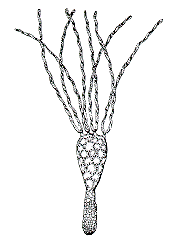| Echinodermata | ||
| Echinodermata | Eocrinoidea |
| Echinoderms |

The Eocrinoids ("dawn crinoids") are among the earliest groups of echinoderms. They had a vase-shaped body (calyx), covered by plates. the plates were symmetrical and bore ridges which meet up with the ridges of other plates, giving a geometrical pattern. Each of the five topmost plates bears a bifurcated brachiole (a slender arm-like food-gathering structure, like the similiar structures in cystoids).
Early eocrinoids, such as Gogia spiralis shown above, were attached to the bottom by a plate-covered thick stem or holdfast. Later eocrinoids evolved a long stalk with columnals, like crinoids and blastoids.
Although the thecal plates are of crystalline calcite (as with crinoids), Eocrinoids are actually more closely related to, and indeed ancestral to, various groups of Blastoids. The group therefore did not die out in the Ordovician or Silurian, but rather continued through its descendents up until the Permian
University of California Museum of Paleontology -- The Eocrinoidea